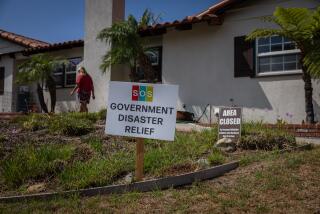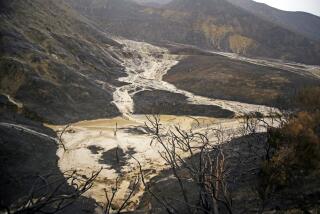Sands and Time Running Out : Erosion: The county’s fiscal crunch has postponed a program to replenish beaches. Residents of tiny Surfside worry the delay could jeopardize their homes.
- Share via
SEAL BEACH — For residents of the tiny community of Surfside, life beside the picturesque Pacific is offset by concern over powerful storms and high tides that for years have eroded sand along the colony’s fragile beach.
Now, Orange County’s bankruptcy has jeopardized a $10-million sand replenishment project by the U.S. Army Corps of Engineers that was scheduled to begin this October, because the county cannot pay its $480,000 share of the cost, officials said Wednesday.
“The problem is that right now we’re not sure we have the financial capability,” said Larry Paul, the county Environmental Management Agency’s manager of coastal facilities.
In a letter to the Corps of Engineers two weeks ago, the county requested a delay of the project until spring, 1996.
Surfside residents, who say they were not told about the letter, are frustrated with the county’s position, according to Eugene (Gino) Salegui, director of the Surfside Storm Water Protection Tax District.
“Because of the bankruptcy, it doesn’t surprise me. But it frustrates me,” Salegui said. “They want to kiss this off for one year and meanwhile we’ve got sand erosion.”
Presently, only 25 yards of beach stand between expensive homes that sell for an average of $737,500 and the ocean at the colony’s northwest corner, said Randy Turnbow, president of Surfside Colony, where about 700 people live.
“The sand fill affects millions of dollars of coastal property,” Turnbow said. “It doesn’t only affect us in Surfside. Instead of costing hundreds of thousands of dollars for sand, it could end up costing millions in potential damage.”
Surfside is regarded as a “feeder” beach. The several million tons of sand deposited there by the Corps of Engineers every five or six years travels south, replenishing Sunset Beach, Bolsa Chica State Beach, Huntington Beach, Huntington State Beach and Newport Beach.
The erosion is worsened by the southern jetty into Anaheim Bay at the Seal Beach Naval Weapons Station. Before the jetty was built in the 1940s, the San Gabriel River would carry sand and silt to littoral currents, helping to plenish the coast.
But the jetty blocks that process. In addition, ocean swells bump off the jetty and produce a reflective wave that scours sand from the northwest portion of the colony’s beach, which is six-tenths of a mile long.
The Corps of Engineers pays about 67% of the restoration program while the state, county, Huntington Beach, Newport Beach and the Surfside tax district pay the rest.
The problem is not as serious at Huntington and Newport beaches, officials said, as it is in Surfside, Sunset Beach and a portion of Bolsa Chica State Beach.
Surfside colony residents fear that waiting another year could be disastrous. They cite this year’s large number of storms and record January rainfall.
Salegui said that before the corps’ sand replenishment project began in 1962, homes in the area suffered major damage from a 1958 storm. He said residents fear a repeat of that time, when “we had people fishing off their front balconies.”
Salegui and residents are hoping for a loan, either from the state or other sources, so the project can continue this year. The corps was scheduled to ask Congress for an appropriation this month to begin the project, but that has been postponed, said Fred-Otto Egeler, a corps spokesman in Los Angeles.
“As it looks now,” Egeler said, “there is no money from Orange County and the state doesn’t currently have the funds to balance out that project. It doesn’t look like we’re going to advertise (for bids) until spring ‘96, unfortunately.”
Surfside is not totally unprotected. Paul said a revetment of boulders buried beneath the sand still protects the colony’s beach.
“We’re currently working on ideas on how to deal with any emergencies” in the event of a severe storm, Paul said. “We do get storm warnings two to three days out and we recognize Surfside’s needs.”
One alternative, Paul said, is to truck sand from other projects, including one in Long Beach, to replenish Surfside’s beach.
Kim Sterrett, who monitors the replenishment area for the state Department of Boating and Waterways, said Surfside residents “are asking a lot.”
“But I guess if I lived there, I would be concerned too,” Sterrett said. “You have to understand that the corps needs to wait until all its eggs are in the basket. That is, you have to have Surfside, the cities, and the county all ready to help pay for this before you ask Congress for the money.”
(BEGIN TEXT OF INFOBOX / INFOGRAPHIC)
Vanishing Beaches Human and natural elements are eroding beaches from Surfside to Newport Beach. The Army Corps of Engineers’ 1995 program for replenishing sand is now in jeopardy because of teh county’sinability to pay for it. The erosion factors: 1. Runoff: Development along San Gabriel River has reduced flow of sand and silt. *
2. Sand Interruption: Jetties interrupt southerly flow of sand and silt. *
3. Reflective waves: Bounce off jetties, increase erosion. *
4. Feeder beach: Currents shift sand from Surfside to southerly beaches. Source: Times reports; Researched by DAVID REYES / Los Angeles Times
More to Read
Sign up for Essential California
The most important California stories and recommendations in your inbox every morning.
You may occasionally receive promotional content from the Los Angeles Times.










